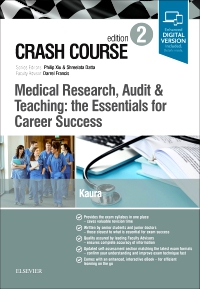
Crash Course Medical Research, Audit and Teaching: the Essentials for Career Success, 2nd Edition
Paperback

-
Section 1 The essentials for career success
1 An introduction to research, audit and teaching
Book purpose
Research methodology
Audit and its loop
Teaching theory and practice
The essentials for career success
Further reading
2 Evidence-based medicine
What is evidence-based medicine?
Formulating clinical questions
Identifying relevant evidence
The search strategy
Search terms
Reviewing the search strategy
Critically appraising the evidence
Evaluating performance
Creating guideline recommendations
Further reading
3 How to get involved
Opportunities for research
Types of projects
Identifying the gap in the evidence
Finding a research supervisor/research group
Project funding
Advice for someone considering a career in academic medicine
Further reading
4 Presenting your research findings
Submitting an abstract for presentation
Selecting the right conference
Writing an abstract
Poster presentations
Oral presentations
Answering audience questions
Further reading
5 Publishing your findings
Writing up a research study manuscript
Submitting a manuscript for publication
Dealing with a rejected manuscript
Further reading
6 Writing a successful curriculum vitae
Is a curriculum vitae necessary?
What is a curriculum vitae?
Writing an effective curriculum vitae
Style and formatting
Common mistakes
Further reading
Section 2 Research methodology
7 Handling data
Types of variables
Types of data
Displaying the distribution of a single variable
Displaying the distribution of two variables
Describing the frequency distribution: central tendency
Describing the frequency distribution: variability
Theoretical distributions
Transformations
Choosing the correct summary measure
Further reading
8 Investigating hypotheses
Hypothesis testing
Choosing a sample
Extrapolating from sample to population
Comparing means and proportions: confidence intervals
The P-value
Statistical significance and clinical significance
Statistical power
References
Further reading
9 Systematic review and meta-analysis
Why do we need systematic reviews?
Evidence synthesis
Meta-analysis
Presenting meta-analyses
Evaluating meta-analyses
Key example of a meta-analysis
Reporting a systematic review
References
Further reading
10 Research design
Obtaining data
Interventional studies
Observational studies
Clinical trials
Bradford-Hill criteria for causation
Choosing the right study design
Further reading
11 Randomized controlled trials
Why choose an interventional study design?
Parallel randomized controlled trial
Confounding, causality and bias
Interpreting the results
Types of randomized controlled trials
Key example of a randomized controlled trial
Reporting a randomized controlled trial
References
Further reading
12 Cohort studies
Study design
Interpreting the results
Confounding, causality and bias
Advantages and disadvantages
Key example of a cohort study
References
Further reading
13 Case–control studies
Study design
Interpreting the results
Case study: risk of constrictive pericarditis
after acute pericarditis
Confounding, causality and bias
Key example of a case–control study
References
Further reading
14 Measures of disease occurrence and
cross-sectional studies
Measures of disease occurrence
Study design
Interpreting the results
Confounding, causality and bias
Key example of a cross-sectional study
References
Further reading
15 Ecological studies
Study design
Interpreting the results
Sources of error in ecological studies
Key example of an ecological study
References
Further reading
16 Case report and case series
Background
Conducting a case report
Conducting a case series
Critical appraisal of a case series
Key examples of case reports
Key example of a case series
References
Further reading
17 Qualitative research
Study design
Organizing and analysing the data
Validity, reliability and transferability
Advantages and disadvantages
Key example of qualitative research
References
Further reading
18 Confounding
What is confounding?
Assessing for potential confounding factors
Controlling for confounding factors
Reporting and interpreting the results
Key example of study confounding
References
Further reading
19 Screening, diagnosis and prognosis
Screening, diagnosis and prognosis
Screening tests
Example of a screening test using likelihood ratios
Diagnostic tests
Evaluating the performance of a diagnostic test
The diagnostic process
Example of a diagnostic test using predictive values
Bias in diagnostic studies
Prognostic tests
References
Further reading
20 Statistical techniques
Choosing appropriate statistical tests
Comparison of one group to a hypothetical value
Comparison of two groups
Comparison of three or more groups
Measures of association
Further reading
21 Economic evaluation
What is health economics?
Economic question and study design
Cost-minimization analysis
Cost-utility analysis
Cost-effectiveness analysis
Cost–benefit analysis
Sensitivity analysis
Further reading
22 Critical appraisal checklists
Critical appraisal
Critical appraisal checklist: systematic reviews and meta-analyses
Critical appraisal checklist: randomized controlled trials
Critical appraisal checklist: diagnostic studies
Critical appraisal checklist: qualitative studies
Further reading
23 Crash course in statistical formulae
Describing the frequency distribution
Extrapolating from ‘sample’ to ‘population’
Study analysis
Test performance
Economic evaluation
Further reading
Section 3 Audit and its loop: the modern approach to improving healthcare practice
24 Clinical audit
An introduction to clinical audit
Planning the audit
Choosing the standards
Audit protocol
Defining the sample
Data collection

 as described in our
as described in our 